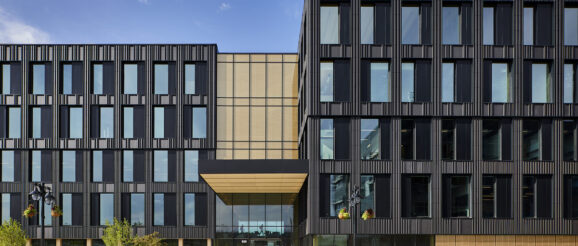Two Canadian architects win Fast Company innovation awards


Fast Company Innovation by Design Awards has recognized Andrea Shin Ling’s Design by Decay, Decay by Design project, and Michael Green Architecture and Katerra’s Catalyst Building among the winners of this year’s program.
The Awards honor the designers and businesses solving the problems of today and tomorrow. The competition, now in its ninth year, has 29 categories, and the judges include renowned designers from a variety of disciplines, business leaders from some of the most innovative companies in the world, and Fast Company’s own writers and editors. Entries are judged on the key ingredients of innovation: functionality, originality, beauty, sustainability, user insight, cultural impact, and business impact.
Ling’s project is a series of artifacts that exhibit designed decay by combining two technologies: Interatomic Coulombic decay (ICT) and biotechnology. 
The research and resulting artifacts were created as part of Ling’s 2019 Ginkgo Bioworks Creative Residency on how to design a world without waste. The project’s base material system included biocomposites of chitin, cellulose, and pectin, derived from the exoskeletons of shrimp, tree pulp waste, and fruit skins.
Located at the South Landing Eco District in Spokane, Washington, the Catalyst building is a five story, 159,000-square foot facility designed by Michael Green Architecture and constructed by Katerra.
The building and the adjacent Scott Morris Center for Energy Innovation demonstrate new building techniques, materials and a sustainable shared energy model that is central to the goal of making Catalyst one of the largest zero energy buildings in North America and one of the first zero carbon buildings to be certified by the International Living Future Institute.

Integrated systems are employed for on-site renewable energy generation using photovoltaic arrays, heating, lighting, and exhaust heat and gray water recovery, as well as Internet of Things (IoT) sensors to optimize operation. Catalyst’s design uses roughly 4,000 cubic meters of locally sourced mass timber products as both structural and design elements, enabling Catalyst to achieve near-passive house levels of thermal performance.
Incorporating mass timber into Catalyst also reduced the need for steel and concrete, helping to collectively offset approximately 5,000 metric tons of carbon, equating to 1,100 cars off the road for a year.

Other “passive-first” strategies included bio swales and water retention system for low water use, envelope design utilizing Passive House standards, and durable material application to achieve design life expectancy of 75 years.
Eastern Washington University is the anchor tenant for Catalyst, with its College of Science, Technology, Engineering and Mathematics (CSTEM) re-locating its electrical engineering, computer science and design programs to the new building. CSTEM is also creating a new program, computer engineering, which will be housed there as well.
Additionally, EWU’s College of Business, several programs from the College of Health Science and Public Health, and EWU’s Creative Writing MFA program will also be based in Catalyst. This will allow more than EWU 1,000 students and faculty to work alongside private industry tenants who will provide hands-on, practical, and multi-disciplinary experiential learning opportunities.
The post Two Canadian architects win Fast Company innovation awards appeared first on Canadian Architect.
